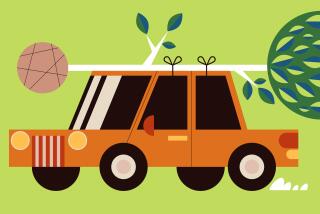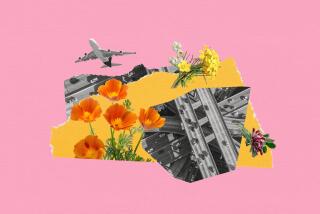GARDENING : Seeing the Trees and the Forest : Bonsai, the art of cutting, wiring and trimming plants to stunt their growth, is an artistic challenge in itself.
- Share via
A warm summer breeze gently rustles the branches of a cluster of liquidambars. Nearby, the leaves of a lonely maple are beginning to change to fall colors. Pine, junipers and elms are nestled close by. A beautiful forest, right? Yes, but with a difference. This “forest” is planted in pots not much deeper than a few inches.
Whether it is because yard space is at a premium or because there is a sense of artistry to this craft, more Southern Californians are turning to the ancient art of bonsai.
This living art, a tree planted in a dish, is relatively new in the United States but carries with it a long history. In China, bonsai has existed for more than 1,500 years. In Japan, the first mention of bonsai appears in the Kamakura Period (1192-1333).
“We’ve noticed an increased interest in bonsai over the past few years,” said Jim Murata, owner of Murata Bonsai Garden in Westminster. The nursery, which deals exclusively with bonsai trees and plants, showcases about 1,000 miniature trees in different varieties. These trees share shelf space with rosebushes the size of teacups, and tiny, delicate ferns.
“Bonsai is a way of combining art and nature,” Murata explained. “By trimming and wiring, you can bend branches and trees in unusual shapes--but you have to know how much the tree can take. If you push too hard, it breaks. The key is to work with the tree, not against it.”
When Murata first opened his nursery 15 years ago, he wasn’t sure if Southern Californians would be interested in the tiny trees and plants.
“In Japan, where I grew up, space is confined so bonsai is very popular,” he explained. “My family was always interested in bonsai. When I came here, I thought it would be wonderful if I could make a living introducing bonsai to others.”
Although there are thousands of different types of bonsai trees, in Southern California, the traditional junipers are the biggest sellers.
“They are the first image that comes to mind when people think of bonsai,” Murata said. “They also do pretty well in this climate. Since they’re evergreens, they look good all year long.”
Trees such as maples, oaks, liquidambars and Chinese elms experience the seasonal changes just like their larger counterparts.
“We don’t sell as many of those in the winter because they lose their leaves,” Murata said, laughing. “People think the trees are dead, when, in fact, they’re simply doing what’s normal. In the spring, when they’re starting to blossom again, they’re very popular.”
The average height of a bonsai tree is about 20 to 25 inches, compared to the 25 to 30 feet they would grow naturally.
“People are very attracted to their small size,” Murata admitted, while fingering the leaves of a small maple. “To see something so big changed into something so small seems almost magical.”
Yet there’s nothing magical about creating a bonsai tree. It takes skill to develop, but after that, Murata claims, their care is relatively easy. The key to success is water and an occasional trim.
“Remember, the trees are in very shallow pots so they tend to dry out quickly,” Murata explained. “For this reason, it’s important to water them frequently--about once a day. As for trimming, care for them is about the same as for other plants. Remove dead leaves and branches, and trim two or three times a year.”
Yet there are those who prefer to start their trees “from scratch.” For these do-it-yourselfers, Murata stocks about 50 varieties of seedlings.
“Americans enjoy doing things by themselves,” he said. “Even though it’s a bit more difficult, they’re at least willing to give it a try.”
If successful, bonsai gardeners can look forward to many years of life from their trees.
“This California juniper is estimated to be about 400 years old,” Murata said, showing off the tree with pride. “What’s unusual about this tree, besides its advanced age, is that it was almost dead. One branch was still living so I grafted a Shimpatu juniper to it. Now the gnarled trunk of the tree supports new life at the top.
“It’s a challenge to work with these trees,” Murata said. “Since they are so small, the focus is on detail and beauty.”
Working on bonsai trees primarily consists of cutting, wiring and trimming to get the desired effect. Depending on the kind of tree, those interested in learning bonsai techniques frequently start with the heartier junipers. Once these have been mastered, bonsai enthusiasts can move on to the more difficult plum trees, fog needle pines and Duzuki azaleas.
Prices for bonsai trees range from $15 to $700, depending on the tree and arrangement selected. According to Murata, one of the most expensive bonsai trees in California recently sold for $10,000.
“Working with bonsai trees is an art,” Murata said. “You can see the creativity of the artist in many of the arrangements, the way trees are grouped, styled, what combinations of plants are used. What’s encouraging to me is that more people are beginning to appreciate bonsai.”
For those who are interested in learning more about bonsai, there are several different organizations and classes in Orange County that can help the beginner or advanced student.
* The Orange Empire Bonsai Society can be reached at P.O. Box 5134, Fullerton, Calif. 92635.
* The Orange Bonsai Society meets in Huntington Beach. Call E.L. Woods at (213) 596-7922 for meeting places and times.
* Murata Bonsai Garden can be reached at (714) 894-4919.






